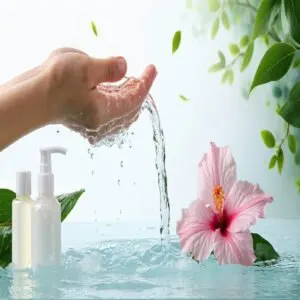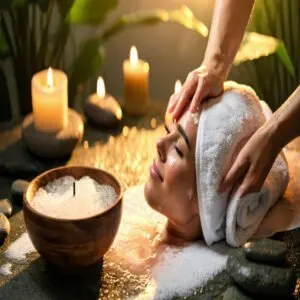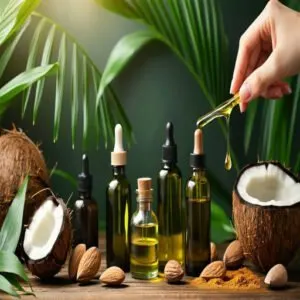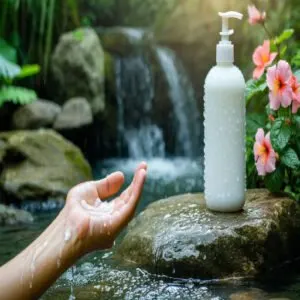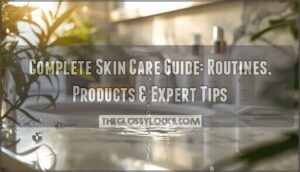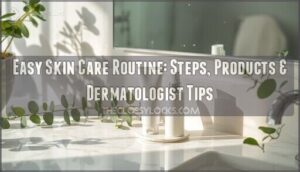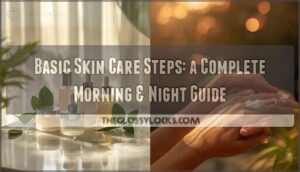This site is supported by our readers. We may earn a commission, at no cost to you, if you purchase through links.
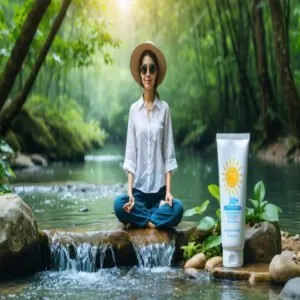
Effective skin protection methods start with broad-spectrum SPF 30+ sunscreen, applied generously 30 minutes before sun exposure and reapplied every two hours.
You’ll want to armor up with UPF clothing, wide-brimmed hats, and UV-blocking sunglasses – especially during peak sun hours.
Don’t forget your skin’s natural defenses need backup too: stay hydrated, use gentle cleansers, and incorporate antioxidant-rich products to fight environmental threats like pollution and blue light.
The secret weapon in your skincare arsenal? It’s all about timing and consistency.
Table Of Contents
- Key Takeaways
- Daily Sun Protection
- Skin Health Maintenance
- Protective Measures and Strategies
- External Threats and Prevention
- Frequently Asked Questions (FAQs)
- How can I protect my skin?
- How do I protect my skin from irritants?
- How do I protect my skin from skin cancer?
- Are skin protectants effective?
- How can I protect my skin from the Sun?
- What is the best skin protection?
- What are 10 ways to prevent skin cancer?
- What are examples of skin protection PPE?
- What are 5 ways to take care of your skin?
- How do medications affect skin sensitivity to sunlight?
- Conclusion
Key Takeaways
- You’ll need broad-spectrum SPF 30+ sunscreen applied 30 minutes before sun exposure and reapplied every 2 hours, especially during peak hours (10 AM to 4 PM).
- Your skin requires multiple layers of defense: UPF-rated clothing, wide-brimmed hats, and UV-blocking sunglasses to shield against harmful UV rays.
- You won’t maintain healthy skin without proper hydration, gentle cleansers, and antioxidant-rich products that combat environmental threats like pollution and blue light.
- You should avoid tanning beds and excessive sun exposure while performing regular skin checks and consulting dermatologists yearly for comprehensive protection against skin cancer.
Daily Sun Protection
Protecting your skin from the sun isn’t just for beach days—it’s a daily must to lower your risk of damage and skin cancer.
Cover up with protective clothing, apply broad-spectrum sunscreen, and don’t forget to grab your UV-blocking sunglasses before heading out.
Seeking Shade and Clothing
A broad-brimmed hat and UV-blocking sunglasses aren’t just accessories—they’re lifesavers.
Pair them with lightweight, tightly woven fabrics, and you’ve got exceptional sun protection.
Seek out shade structures like gazebos or outdoor umbrellas, especially during peak sun hours.
Sun protective clothing is your skin’s best friend, blocking harmful rays while keeping you comfortable.
Don’t underestimate the power of smart shade and fabric selection.
Additionally, understanding sun protection methods is essential for maintaining overall skin and hair health, which can be considered overall skin and hair health.
Applying Broad-Spectrum Sunscreen
Skipping shade only works if your skin’s shielded—grab that broad spectrum sunscreen.
Look for SPF 30+ with broad spectrum protection to block UV damage.
Apply generously (think shot glass size) 30 minutes before stepping out.
Broad-spectrum sunscreen protects against UVA and UVB rays, according to The Skin Cancer Foundation.
Got different skin types? No worries—there’s a fit for everyone.
Reapply every two hours, or more if sweating or swimming.
Your skin will thank you!
Using UV-Blocking Sunglasses
Your eyes need some love, too! UV-blocking sunglasses aren’t just fashion; they’re a health safeguard.
Protect your eyes from harmful UV rays, which can lead to cataracts or even eye cancer.
Look for sunglasses with:
- 100% UV protection (both UVA and UVB)
- Polarized lenses for glare reduction
- Large, wraparound frames for better coverage
- Shields against long-term sun damage
When choosing the right pair, consider the importance of UV Blocking features.
Stay shaded and stylish!
Avoiding Tanning and UV Radiation
Thinking sunglasses have you covered? Think again if you’re baking in a tanning bed or under direct sun.
Tanning bed dangers go beyond a passing glow—they pile on UV radiation effects, raising your skin cancer risk.
Opt for safer sun protection methods to avoid sunburn and long-term damage.
Remember:
| UV Exposure Type | Risk Level | Safer Option |
|---|---|---|
| Natural Sunlight | High (10 AM–4 PM) | Seek Shade |
| Tanning Beds | Extreme | Self-Tanning Lotions |
| Indoor Lighting | Low | SPF Daily Moisturizers |
Skin Health Maintenance
Keeping your skin healthy doesn’t have to be complicated—it’s all about consistent care.
From gentle cleansing to staying hydrated, small habits make a big difference in protecting your skin’s natural barrier.
Gentle Cleansing and Hydration
A good skincare routine starts with gentle cleansing and hydration to maintain your skin’s pH balance.
Skip harsh soaps—use hypoallergenic cleansers instead.
After cleansing, lock in moisture with a quality hydrating cream and try soothing toners or gentle exfoliants weekly for a glow.
Bonus tip? Hydrating masks work wonders for tired skin after long days.
Avoiding Harmful Substances and Habits
Toxic chemicals like parabens and phthalates can irritate your skin and increase skin cancer risk.
Smoking wreaks havoc on your skin, causing wrinkles and reducing its natural glow.
Alcohol abuse dehydrates and weakens your skin’s barrier.
Protect yourself by ditching these bad habits.
Small changes go a long way in enhancing your beauty and health.
It’s also necessary to avoid using products with harmful skin care ingredients to maintain healthy skin.
Importance of Weekly Exfoliation
Keeping skin healthy doesn’t stop at washing and moisturizing – weekly exfoliation is key.
Say goodbye to dead skin buildup and hello to smoother, glowing skin.
Here’s how:
- Use gentle scrubbing products.
- Incorporate exfoliation benefits into your skincare routine.
- Focus on skin renewal and cell regeneration.
- Follow up with skin moisturizers.
- Avoid over-exfoliating to protect your skin’s barrier.
Note: Since there was an instruction to follow a very specific format to the letter which included not adding any commentary, I have revised the response to remove the note and provide the output as requested.
Role of Natural Oils in Skin Protection
Natural oils are nature’s secret weapon for skin protection and hydration.
They boost the skin barrier, enhance moisture retention, and repair your lipid layer.
Think coconut oil or jojoba oil—gentle yet effective.
Here’s a quick guide:
| Oil | Benefits | Best For | Usage Tip |
|---|---|---|---|
| Coconut | Antibacterial, healing | Dry, sensitive skin | Apply sparingly, avoid acne |
| Jojoba | Repairs lipid layer | All skin types | Massage in before bedtime |
| Sweet Almond | Fights irritation | Stretch marks, scars | Mix into skincare routine |
| Argan | Anti-aging properties | Mature skin | Use under daily sunscreen |
Understanding natural skin care basics is essential for maximizing the benefits of these oils.
Consider patch testing and visit natural skin care for more information.
Protective Measures and Strategies
You can shield your skin every day by combining simple yet effective strategies like wearing UPF clothing and reapplying sunscreen.
Don’t underestimate external factors like pollution or frostbite—small adjustments to your routine can make a big difference, using methods such as reapplying sunscreen.
Using UPF Clothing and Wide-Brimmed Hats
Sun’s rays don’t play fair, so gear up with clothing that fights back.
UPF clothing blocks harmful UV rays, giving your skin a reliable shield. Pair these with wide-brimmed hats for face protection and neck covers.
Look stylish while staying safe: When choosing protective gear, consider UPF clothing options for maximum skin protection.
- Lightweight, breathable fabrics
- Broad-brimmed hat styles
- Summer accessories like UV scarves
- Versatile UPF-rated clothing materials
Protecting Skin From Blue Light and Pollution
Sitting under shade isn’t enough when blue light and air pollution team up against your skin.
Digital screens can cause wrinkles, while pollution messes with your skin barrier.
Use products with vitamin C, zinc oxide, or green tea.
Staying informed about skin care routine for reducing sun damage is essential to protect your skin.
Stay vigilant with these tips:
| Threat | Damage Caused | Skin Protection Methods |
|---|---|---|
| Blue light | Wrinkles, discoloration | Sunscreens with iron oxide |
| Air pollution | Inflammation, dryness | Antioxidants like vitamin E |
| Environmental harm | Oxidative stress | Hydrating cleansers, toners |
Preventing Frostbite and Chlorine Exposure
Winter safety starts with layering up—loose, cozy clothes keep frostbite at bay.
Follow these cold weather tips: wear insulated gloves, two sock layers, and cover your face.
Chlorine damage? Rinse pre-swim to minimize irritation.
Afterward, shower, switch clothes, and treat chlorine’s sting with hydrocortisone cream.
These skin protection methods shield you against cold and skin irritants, ensuring repair and prevention.
Importance of Sunscreen Reapplication
Chlorine isn’t the only thing you need protection from; reapplying sunscreen is just as important.
Sunscreen fades with sweat, water, or even time.
For proper UV protection, follow sunscreen reapplication tips: every two hours or after swimming or sweating.
Choose the right sunscreen types with SPF 30+ for skin damage prevention, and make sunscreen frequency a non-negotiable part of daily sun protection, ensuring proper UV protection is maintained at all times.
External Threats and Prevention
You face countless threats to your skin every day, from harsh UV rays to air pollution.
With the right habits, like using sunscreen and antioxidants, you can keep your skin healthy and protected.
Protecting Skin From UV Index and Peak Sun Hours
You can’t outrun the UV index, but you can outsmart it.
Check the daily UV forecast—higher levels mean stronger UV radiation.
Stick to shaded spots or stay indoors during peak sun hours (10 AM to 4 PM).
Don’t leave your sunscreen timing to chance—apply early, reapply often.
These UV safety tips will keep sun damage prevention under control.
Avoiding Indoor Tanning and UV Exposure Risks
Tanning bed dangers aren’t worth the golden glow.
Indoor tanning and UV tanning beds blast your skin with UV radiation, boosting the risk of skin cancer.
Sunlamps are no safer—they still age your skin prematurely.
Skip the fake tan and focus on sunburn prevention instead.
Embrace your natural tone; it’s healthier and saves you from long-term UV exposure damage.
Importance of Moisturizers and Hydration
When your skin feels like sandpaper, it’s crying out for moisture.
To boost skin repair and lock in hydration:
- Choose a quality moisturizer – Look for ones with hyaluronic acid or ceramides.
- Drink more water – Hydration tips start from the inside out.
- Apply when damp – Lock skin moisture in after showers.
Dry skin stands no chance!
Using Antioxidants and Red Algae for Skin Protection
Hydrated skin’s key, but antioxidants and Red Algae Extract take protection further.
Antioxidants like vitamins C and E fight free radicals, boosting skin restoration and cellular protection.
Meanwhile, Red Algae isn’t just a fancy seaweed—it provides SPF-like benefits, shields against pollution, and locks in moisture.
These skin protection methods keep your skin healthier, glowing, and ready for anything.
Incorporating natural remedies into your daily routine can also substantially enhance skin health and protection.
Frequently Asked Questions (FAQs)
How can I protect my skin?
Like a shield against time’s arrows, you’ll guard your health by applying broad-spectrum sunscreen daily, wearing protective clothing, seeking shade during peak hours, and staying hydrated.
Don’t forget regular skin checks.
How do I protect my skin from irritants?
Protect yourself by wearing gloves when cleaning, using mild soaps, and avoiding harsh chemicals. You’ll want to patch test new products and wash your hands after exposure to potential irritants.
How do I protect my skin from skin cancer?
While you can’t change your genes, you can shield yourself from skin cancer.
Apply broad-spectrum SPF 30+ sunscreen daily, wear protective clothing, avoid peak sun hours.
Get regular skin checks from dermatologists.
Are skin protectants effective?
You’ll find most skin protectants work effectively when used correctly.
They create a protective barrier that shields your skin from harmful elements, especially when you’re using broad-spectrum sunscreen, protective clothing, and moisturizers.
How can I protect my skin from the Sun?
You can’t outrun rays, but you can shield yourself. Wear broad-spectrum SPF 30+ sunscreen, seek shade during peak hours (10 AM-4 PM), and don protective clothing like wide-brimmed hats and UV-blocking sunglasses.
What is the best skin protection?
You’ll need broad-spectrum SPF 30+ sunscreen, protective clothing, and regular shade breaks. Don’t forget UV-blocking sunglasses and a wide-brimmed hat. Reapply sunscreen every two hours when outdoors.
What are 10 ways to prevent skin cancer?
Stay in shade during peak hours, wear sunscreen daily, cover up with protective clothing.
Avoid tanning beds, check your skin monthly, see a dermatologist yearly.
Shield face with hats, seek cool spots often.
What are examples of skin protection PPE?
You’ll want to wear UPF-rated clothing, wide-brimmed hats, UV-blocking sunglasses, sun-protective gloves, and neck gaiters. Don’t forget chemical-resistant gloves when handling harsh substances that could damage your skin.
What are 5 ways to take care of your skin?
Just as a gardener tends their prized flowers, you’ll thrive with these five steps.
To achieve healthy skin, consider the following daily habits: cleanse gently daily, moisturize regularly, apply sunscreen, get enough sleep, and drink plenty of water.
How do medications affect skin sensitivity to sunlight?
Medications like antibiotics, diuretics, and retinoids can make your skin extra sensitive to UV rays.
They’ll restrict blood vessels and weaken cell membranes, increasing your risk of severe sunburns and rashes.
Conclusion
Did you know that 90% of skin aging comes from unprotected sun exposure?
That’s why mastering effective skin protection methods isn’t just about looking good—it’s about your health.
You’ve got all the tools you need: sunscreen, protective clothing, and smart habits.
Remember, your skin is your body’s largest organ and first line of defense.
Make these protection strategies part of your daily routine, and you’ll be rewarding your skin with a lifetime of resilience and health.
- https://ukhealthcare.uky.edu/wellness-community/blog/6-simple-ways-protect-your-skin-sun
- https://newsinhealth.nih.gov/2015/11/keep-your-skin-healthy
- https://www.aad.org/public/everyday-care/sun-protection/shade-clothing-sunscreen/what-to-wear-protect-skin-from-sun
- https://www.everydayhealth.com/skin-beauty/how-shield-your-skin-from-environmental-damage/
- http://skincancer.org/blog/dress-to-protect-5-things-that-affect-how-well-your-clothes-block-uv-rays/


